Tlaxco is one of 2 Pueblos Mágicos, or Magical Towns, in Mexico’s smallest state, Tlaxcala (the other is Huamantla). A relative newcomer in the tourism scene, Tlaxco was designated as a Pueblo Mágico in 2015 by the Mexican Secretary of Tourism.
It’s only a 3-hour bus ride from Mexico City, but you’ll find plenty of adventures in Tlaxco that make it worthy of more than just a day-trip.
The entire little state of Tlaxcala is the epitome of a “hidden gem”. I’ve even met Mexicans who have never heard of it. A recent tourism slogan exclaims, “Tlaxcala does exist” (#TlaxcalaSíExiste).
In pop culture, the 1998 movie, “The Mask of Zorro”, gives a quick shout-out to Tlaxco. Zorro (Antonio Banderas) and his brother were captured, and the bounty hunter was told to collect his bounty in Tlaxco.
Tlaxco, a town of 15,000 residents, sits at an elevation of 2,550 m (8,366 ft). On the outskirts of town, you can hike up forested “hills” to about 3,500 m (11,500 ft). If you’re a flatlander like me, we call them mountains.
History
Pre-Hispanic History
In the pre-Hispanic Náhuatl language, tlachtli means, “ball sport”, and co means “place of”. Hence, Tlaxco roughly translates to “place of the ball sport”. Although many of the ball sport rules were lost over time, some clues have been found in ancient murals and codices.
One aspect of the game involves players getting the automatic win by using their hips to knock a rubber ball through a stone ring. The ring is like a sideways basketball hoop. Or if you’re a Harry Potter fan, it’s like knocking the quaffle through a small quidditch hoop, which ends in an epic “golden snitch” style instant win. I digress…
Tlaxcalteca warriors were some of the fiercest rivals of the mighty Aztecs. Tlaxco, due to its high altitude, was a training ground where warriors grew strong for battle. You can still find obsidian arrowheads and other artefacts scattered throughout the forested hills around town.
Colonial Times
Tlaxco has about 25 haciendas, some of which date back to the 16th century. A few have been beautifully restored and/or continually cared for through generations, including Santa María Xalostoc and San Diego Xochuca. You can book a room in either one, or stop by for a taste of the traditional “nectar of Aztec gods and kings” known as pulque, which is produced on the premises.
Tlaxco’s Palacio Municipal (town hall) was inaugurated by Mexican President Porfirio Díaz in 1894. Díaz led Mexico for 31 years during a period of industrial and economic revolution known as the Porfiriato.
As a generous gift, President Porfirio Díaz donated two ornate, golden French mirrors to the building. Today, they still hang on the wall in the room opposite the main entrance of the Palacio Municipal.
After the inauguration, the President visited the old Plaza de Toros, which is currently the Madem Wood Museum.
The Mexican Revolution
There are supposedly tunnels, beneath the central church, which lead to the current Cultural Center and other parts of town. Rumor has it they were used during the Mexican Revolution in the 1910s. But they were later blocked off because of hazardous explosives possibly still down there.
During the chaos of the Revolution, people often hid gold coins and other valuable objects underground or in forests around town. They even built secret, subterranean shelters to hide people and valuables.
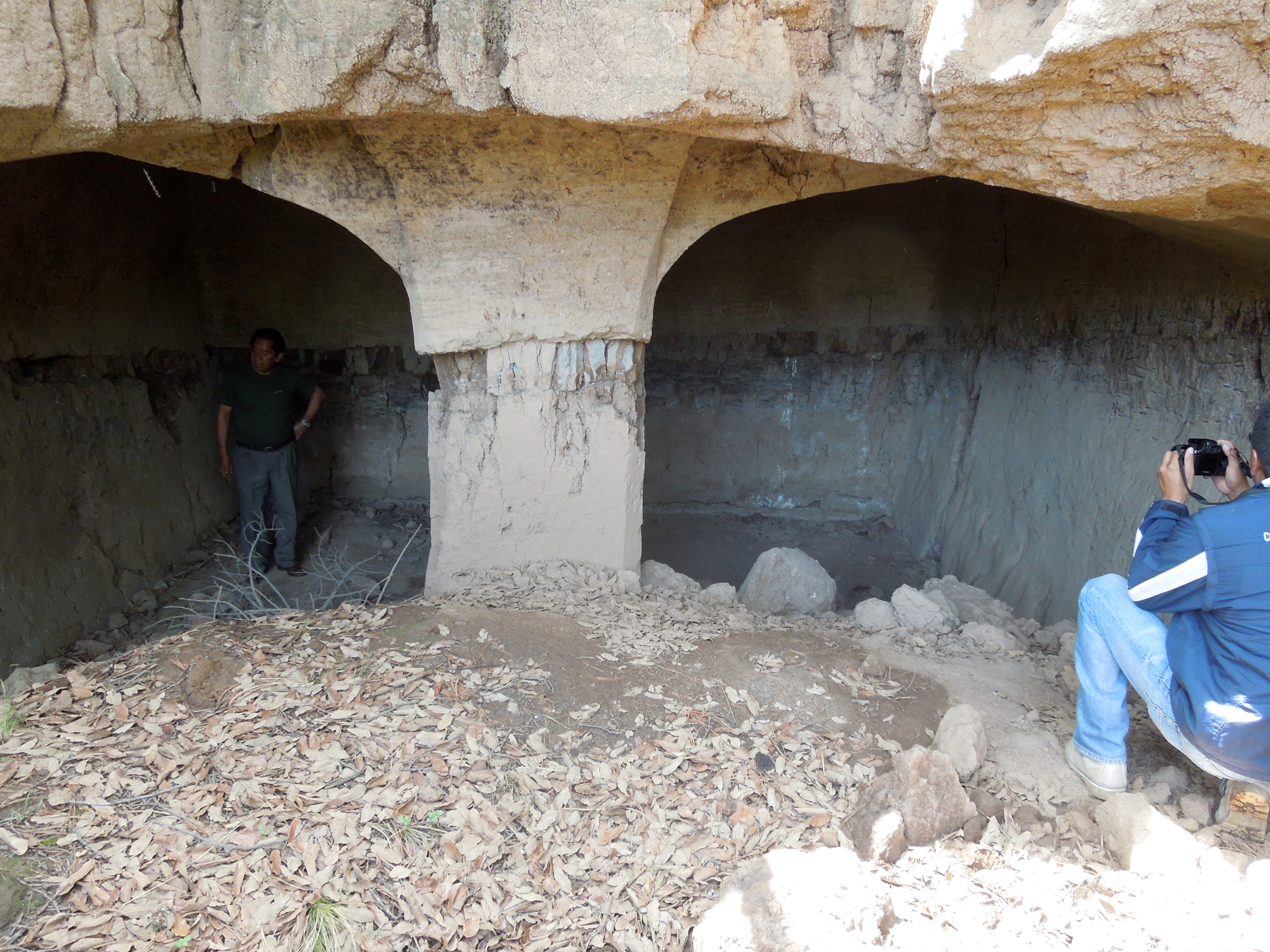
To learn more about the rich history of Tlaxco, and to experience it through photos, artwork, and ancient artefacts, be sure to visit the Carlos González Tlaxco Museum. You can also contact the director of the museum, Jorge Esteban López García, for hacienda and pulque tours.
Churches
The main church in Tlaxco is the Iglesia de San Agustín, located right in the downtown Centro. The first thing you’ll notice upon entering is the impressive gold-painted interior. My favorite part, however, is the old paintings you’ll find in the chambers behind the altar.
The Iglesia de San Agustín might be the most beautiful on the inside, but the Iglesia de la Virgen de Lourdes is the prettiest on the outside. It’s only a five or ten minute walk east of the Centro, and the desolate hills provide a nice backdrop. You can see it on your way to hike the Laberintos.
San Andrés Buenavista is a community in the south of Tlaxco, a bit of a trek from downtown, but it’s home to one of the most unique churches you’ll ever see: La Barca de la Fe. It takes on the form of a ship as a tribute to San Andrés the fisherman.
Best Time to Visit
Climate
Rainy season is June through November. Rains are typically brief and in the afternoons. Days are hottest in May, but they rarely get above 27°C (80°F) and it always cools down quite a bit in the evenings. May is also the end of the dry season, so it can get pretty windy and even a bit dusty. Mosquitoes are never an issue because of the altitude.
Regional Fairs
Tlaxco is famous for cheese, wood, and pulque, which are all celebrated during the week-long San Agustín Fair every year around August 28th. There’s a second annual Pulque Fair for a weekend near the spring equinox (March 18-19 in 2023), and an Artisan Fair in June.
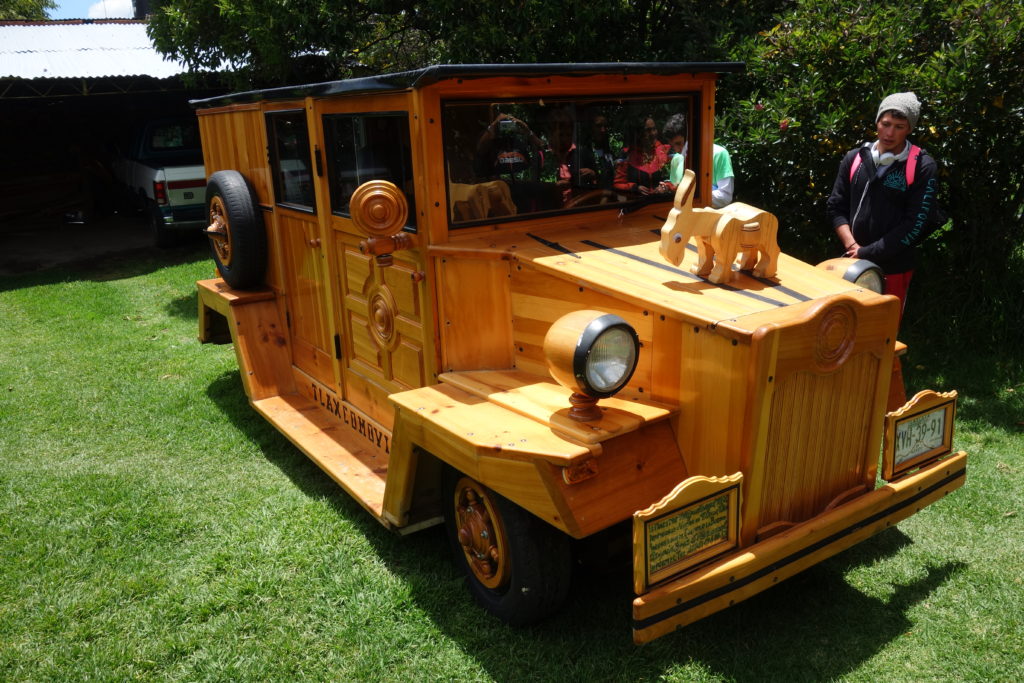
Regional Specialties
Tlaxco’s carpentry museum, Madem, can be visited any time of year (except Tuesdays), and is the home of the famous Tlaxcomobile, a completely functional, one-of-a-kind wooden car created by Don Miguel Márquez.
The town also has a couple silver workshops, where you can buy quality jewelry directly from artists who will teach you all about the process.
Check out the artisan market for some other arts and crafts, including organic products from Otma Fusion.
Several cheese shops line the main road along the southern part of town. I recommend the smoked cheese from Quesería Brian. To make quesadillas, get some quesillo from the Quesería Tierra Nueva. It’s like a never-ending string cheese wrapped into a big ball. Stop by the legendary hole-in-the-wall, Quesos Tía Nila, right by the Centro for fresh ricotta or queso de tenate.
Although flavored pulque is sold in the centro on weekends, it’s not always easy to find the quality, natural stuff when there’s no festival going on. Get in touch with Jorge Lopez Garcia at the Museo de Tlaxco for pulque and/or hacienda tours. He can show you the best hole-in-the-wall pulquerías that don’t show up on Google Maps.
Some of the best tinacales, or places that produce pulque, are at Hacienda Xochuca, Coralillo, Cruz Negra, and Las Mesas. They’re mostly a bit of a drive from downtown Tlaxco, and they mostly don’t get cell service, just so you know.
Famous People from Tlaxco
Tlaxco native Victoria Dorantes is not well-known outside of Mexico, but it’s hard to find a Mexican who doesn’t know her image. A portrait of her, known as “La Patria”, painted by Jorge González Camarena, became the iconic image used in every public elementary school textbook distributed free of charge by the Mexican Secretary of Public Education since 1961. You can see a statue of her in the Centro park.
Sergio and Rafael Goyri are famous actors. Sergio is well-known for his soap operas, while Rafael is more known for action movies. Although they’re originally from Puebla, their family owns some cabañas where you can spend the night in the middle of the Tlaxco forests.
Guided Tours
In addition to hacienda and pulque tours, you can reserve hiking, biking, bus, and hot-air balloon tours with authorized guides from the Recorre Tlaxco tourism agency. Soar above town at sunrise for a peaceful, 360° view including some of Mexico’s massive volcanoes.
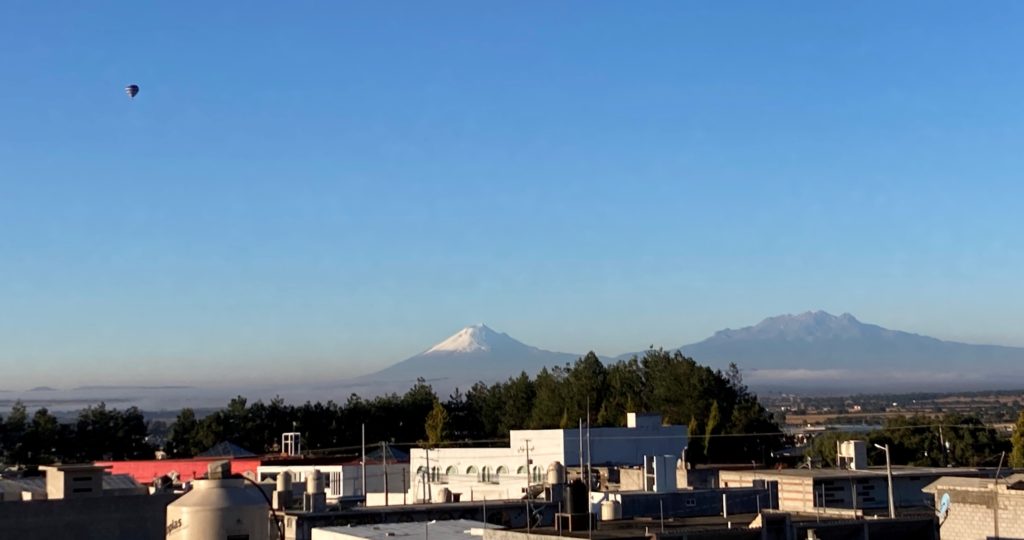
Best Hiking in Tlaxco
There are plenty of pine-oak forests and rock formations to climb and explore in the region, but you should be aware that many are on private property. Nevertheless, you can click the link a few lines up to contact authorized tour guides who can help coordinate with landowners and get you access.
Keep an eye out for beautiful flora and fauna: You can see colorful wildflowers and a variety of animals along trails, including peregrine falcons, vermillion flycatchers, coyotes, hummingbirds, lizards, frogs, roadrunners, and rattlesnakes.
La Peña del Rosario / La Peña del Rey
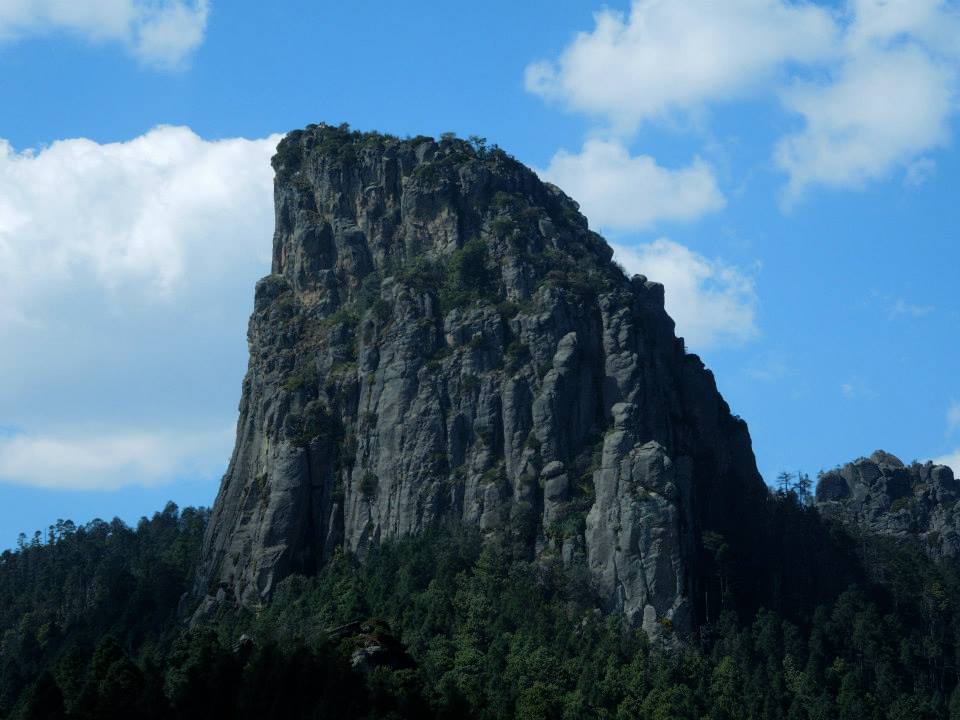
One of the most prominent rock formations overlooking Tlaxco is La Peña Del Rosario, recently rebranded as La Peña del Rey. From the summit of 3,450 m (11,300 ft), you’ll have a 360° view including 4 of the biggest volcanoes in Mexico! For a similar view without all the hiking, try the hot-air balloon tours mentioned above.
The hike is not easy and you should set aside several hours if you want to reach the summit. Near the top, you’ll need to use your hands to climb over some rocks, and you’ll have to walk along some trails on the side of a cliff. It’s not easy for people afraid of heights.
To make the approach a bit easier, you can rent ATVs, eat over a campfire, and camp for a night on the way up. And of course, you could always just hang out in the beautiful forests below the Peña. Visit the official site to plan your visit.
La Peñuela, Rappel, and Ancient Cave Paintings
Another great place for camping and hiking is Campamento La Peñuela. You can rappel down a cliff and venture into a cave with bats, if you’re adventurous. The coolest thing about this place is the ancient cave paintings, which are over 10,000 years old!
Los Laberintos
Erosion by wind and water caused the formation of Los Laberintos, The Labyrinths, on the east side of town. These slot canyons are not too difficult to navigate, and they’re just a 15-minute walk from the centro park.
To get there from the Centro, just find Cinco de Mayo Avenue a block north of the main church and turn east. You’ll pass a couple more churches, first El Calvario, then the Capilla de Lourdes which is my favorite with its old-fashioned stone architecture. Shortly after, the road turns into a dirt road leading to Los Laberintos.
La Malinche
If you’re a serious hiker, you should take a day-trip to climb La Malinche, a 14,600 ft (4,460 m) stratovolcano higher than any peak in Colorado.
Best Places to Eat (and Drink) in Tlaxco
Traditional Regional Food
Café 34 – My personal favorite to grab lunch or a weekend buffet. Ask what they have for the $65 MXN ($3.25 USD) comida corrida of the day. The hearty, three-course meal will fill you up and delight your pallete. You can also order something from the menu if you prefer more options. On weekends, they do an all-you-can-eat brunch buffet.
La Casona de Don Agustín – This restaurant, overlooking the central park, was built over 200 years ago, and you can feel the building’s history as you enter. A great place for traditional food with flavors passed down through generations.
The owner, Don Germán, is one of the town’s main promoters of tourism, and he’s always excited to share the fascinating history of Tlaxco with any visitors who sit down for a meal.
El Rincón Taurino – A nice place right on the edge of the central park with solid regional food and bullfighting memorabilia lining the walls.
Portal Jardín – This is the only place I know of with escamoles, or ant eggs, on the menu. They don’t look as scary as they sound, with the texture and flavor of buttery rice. Those with an adventurous appetite might want to try them, but the place serves plenty of other tasty dishes, sans insects.
“Vitamin T” (Tacos, Tortas, Tamales, Tlacoyos…) and Other Street Food
You can’t go wrong with classic street tacos at night in the Centro park: al pastor, bistec, longaniza, suadero, lengua, tripas… with a sprinkle of cilantro and onion, a squeeze of lime and spicy salsa.
From the Centro, walk around to the back of the church for quesadillas and a heartier taco at Taco Melón. Here you can order tacos with bistec, chuleta, chistorra, costilla, pechuga, or my favorite, chorizo argentino, and they all come loaded with potatoes, nopales, and grilled onions.
Tacos de Canasta – These classic Tlaxcala-born tacos can now be found throughout the country. Look for a vendor with a big basket lined with blue plastic. One vender sets up shop at the Pemex gas station a couple blocks south of the Centro.
Tortas Tlaxco – Although there are many options for tasty, toasted tortas in Tlaxco, this is one of my favorites. It’s on the main drag, four blocks south of the Centro park on Francisco I. Madero Street.
Barbacoa and Consomé – My favorite place is a hole-in-the-wall with no name, only open on Sundays. Find a big, brown, metal door a half block north of the Pemex gas station. It’s across the street from Farmacia Guadalajara. Inside is a wooden box filled with the meat of a tender, slow-roasted lamb. Arrive early, because they often have nothing left by 11 a.m.
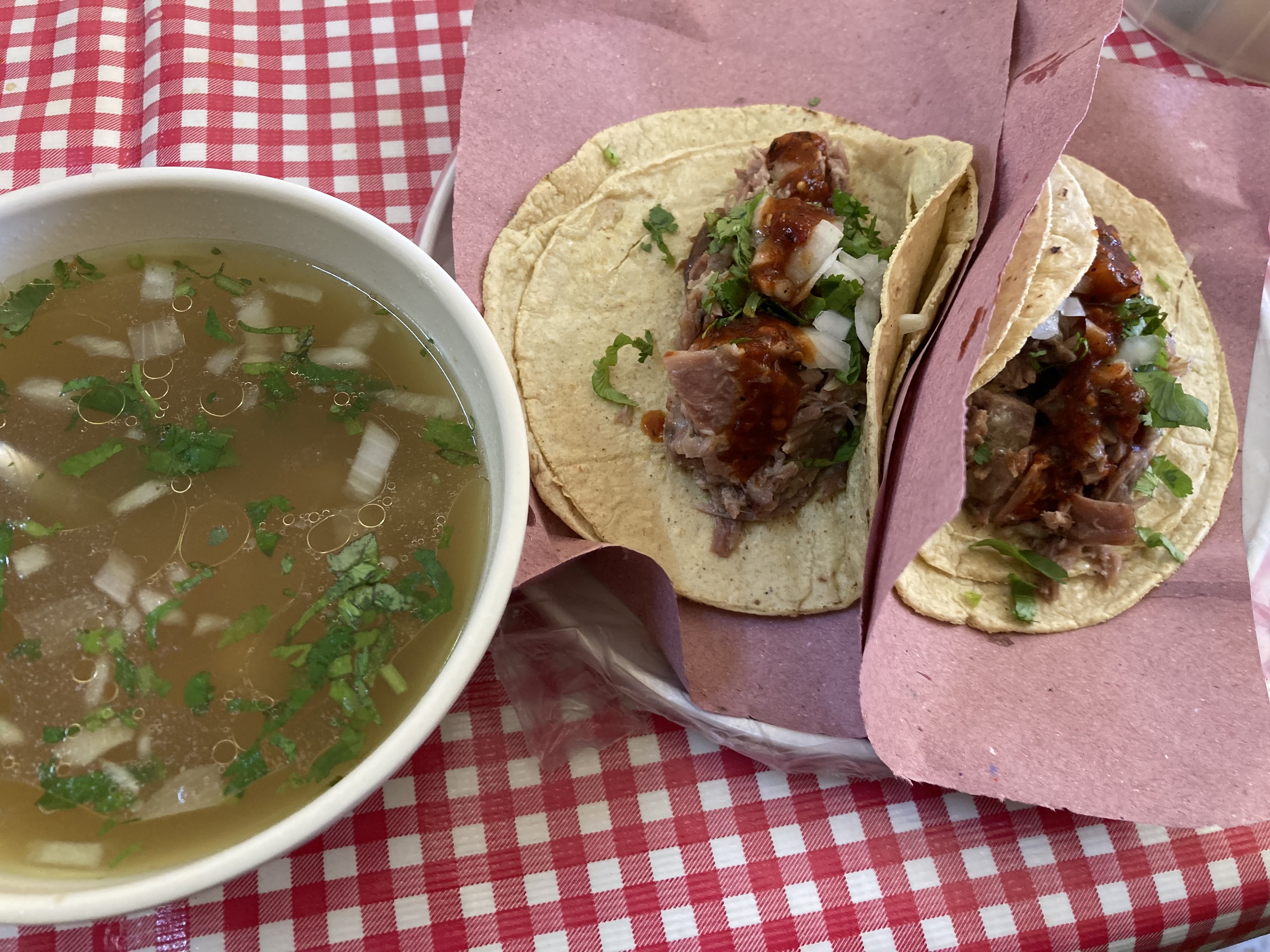
Wings, Burgers, and Pizza
La Azotea – This place has a calm atmosphere with a rooftop patio. I always order the boneless wings and some fries, but they have solid burgers and clay-oven pizzas as well. Bring a jacket because evenings can get chilly.
If you enjoy a good craft beer (sometimes difficult to find in Mexico), ask about the selection from the local Skål microbrewery. They brew classics like Baltic stout, pale ale, and hefeweizen, as well as some experimental beers with unique flavors like spicy chipotle or Montezuma cypress.
The owner of La Azotea, Germán, also works in the tourism industry. He’s your guy for anything from hiking and biking tours to hot-air balloon rides (if this all sounds familiar, his father was mentioned above as the owner of La Casona de Don Agustín and another resource for tourism info).
El Chef – Nice little café with great pizzas and good burgers. My favorite is the seafood pizza (even though shrimp is the only seafood on it).
Vegetarian
La Tienda de Don Mariano – This is the best place for a coffee in town, and they have craft beers as well. It’s an eco-friendly café offering plenty of options for an organic, vegetarian meal. You can also buy some snacks, coffee, chocolate, or arts and crafts to take with you.
The owner, Alejandra Caballero, is an architect who gives immersive workshops in bioconstruction techniques and vegetarian cooking in the beautiful forests just north of town. Check out the course offerings at Proyecto San Isidro.
Seafood
Mariscos del Checo – This Nayarit-style seafood place is a few kilometers south of downtown Tlaxco. It’s known for the salmon, which you can order by the kilo for the whole family. They also serve refreshing, citrusy tequila drinks.
Marisquería La Isla – Tasty fish fillets and shrimp platters prepared in a variety of ways from spicy to garlicky.
How to Get Around in Tlaxco
There is no Uber service available in Tlaxco, but white taxis are fairly easy to find near the Centro. There are usually a few at the southeast corner of the main park, and a few on each corner if you walk south along the main Francisco I. Madero St.
Since I’ve lived in Tlaxco for 8 years, I know a couple great, trustworthy taxi drivers. Roberto Castilla Carrasco is a cab driver on call 24/7, so feel free to call him up or send a WhatsApp to (+52) 241 140 0853 to arrange for a ride.
How to Get to Tlaxco
From Mexico City TAPO Bus Terminal
From Mexico City, get to the Terminal de Autobuses de Pasajeros de Oriente (TAPO). If you take the Metro, the TAPO is right at the San Lázaro stop on the pink line. There you can buy a ticket to Tlaxco with the ATAH / Supra company for $266 MXN ($13 USD). The fairly comfortable, bathroom-equipped bus only makes one stop along the way (in Apizaco) and it should get you to Tlaxco in about 3 hours.
*Pro tip: If the next available bus to Tlaxco won’t leave for a while, ask about the next one to Apizaco. Apizaco has a more frequent schedule. However, you’ll have to make one easy transfer at the Apizaco terminal and get on a bus to Tlaxco (40 minutes, no bathroom) from there.
From Mexico City Central Del Norte Bus Terminal
You can also make the trip from Central Del Norte in Mexico City, although the Teotihuacanos bus line doesn’t have bathrooms, and the trip depends on how many stops are requested along the way, so it could range from about 3-5 hours.
However, an advantage of this route is that it stops right at the entrance of the Teotihuacán archaeological site, so you could stop there and check out the famous pyramids. This bus is also a little bit cheaper than the one from the TAPO bus terminal.
From Puebla CAPU Bus Terminal
Find the ATAH buses to Tlaxco, which is a little tricky because there are two booths for buying ATAH tickets, and you need to find the one near the end of a long hallway. Tickets to Tlaxco are $74 MXN ($4 USD) and will get you there in roughly 2 hours.
Hotels, Cabañas, and Haciendas
Hotels
There are a few hotel options in downtown Tlaxco, including the Posada Portal Jardín, and the recently inaugurated Alquería Central Hotel Boutique ($750 MXN / $40 USD per night), both of which are within a couple blocks of the Centro.
But if you can venture into the outskirts of town, I recommend staying in a cabaña or ex-hacienda for a truly special night among scenic forests, starry skies, and/or historic architecture.
Cabañas for Nature Lovers
Rancho Escondido Casa Goyri – Book a cabaña or double room starting at $1,200 MXN (~$60 USD). Stay in ecological adobe buildings with solar panels and filtered mountain spring water (a rare luxury in Mexico).
This charming, yet expansive property has plenty of activities, including a swimming pool, playground, exercise areas, pool tables, foosball tables, ATV rentals, and they say there’s even a night club on weekends.
They can get a campfire going for you and provide firewood for $150 MXN ($7.50 USD). My personal favorite feature is the gorgeous forests and hills to explore around the property. When we asked about the check-out time, they said, “whenever you want”. Which allowed more time for exploring on the morning of our departure.
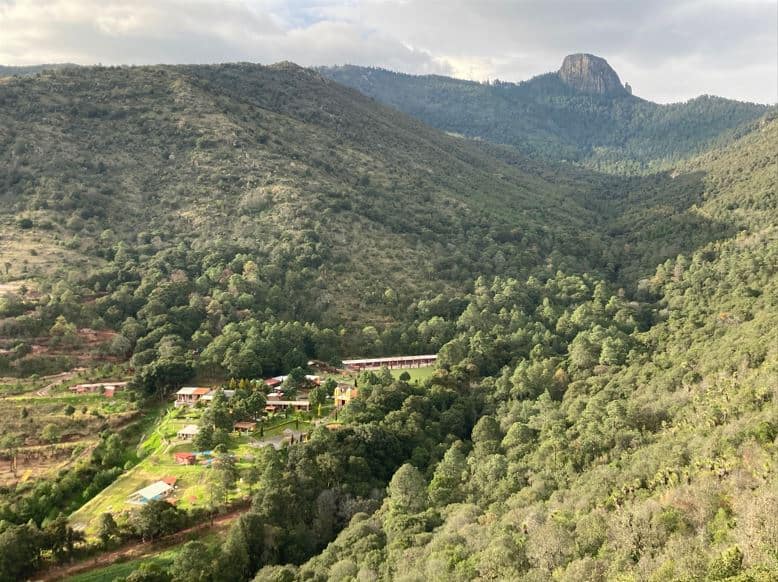
At $180 MXN ($9 USD) for a meal, the on-site restaurant is pricier than options in town, but the 3-course meal with regional flavors is certain to satisfy. Although there’s no cell signal in the area, there is free WiFi in the restaurant on the property.
Bonus: On your way to Rancho Escondido Casa Goyri, as you turn off the main road, you’ll drive right by the Hacienda San Diego Xochuca, so you can stop by and find someone to serve you their famous pulque.
Fun fact: This family-run business is funded by actors Sergio and Rafael Goyri. Movie posters line the walls of the restaurant and game room. To be honest, I’ve never seen their shows nor movies, but the posters have a sort of Steven Seagal vibe.
El Llano del Conejo and El Final de la Senda are also great places to rent cabañas at the edge of the forest. The properties are pretty much next-door to each other to the north of Tlaxco, and both offer similar services; restaurant, ziplines, ATV rentals, horseback riding, hiking, cabins, and camping. Both are popular family retreats for a weekend afternoon of grilling carne asada.
Haciendas
Hacienda Santa Maria Xalostoc – This 16th century hacienda has won awards for its restauration efforts. Its gardens and accommodations will take you back in time through historical architecture complemented by colorful flora. If you want to stay the night, rooms start around $1330 MXN ($66 USD). Some include fireplaces and/or bathtubs.
Hacienda San Diego Xochuca – Xochuca was constructed in the 19th century. Although the rustic architecture is not quite as charming as Xalostoc, this is a mecca for learning about and trying pulque, the pre-Hispanic alcoholic nectar of Aztec gods and kings. It’s also in the foothills of La Peña del Rosario, in case you want to do some hiking. Rooms start at around $700 MXN ($35 USD).
Final Note
So is Tlaxco really worth a visit? Absolutely! Whether you’re interested in the culture, history, or just a weekend escape from the hustle and bustle of Mexico City, Tlaxco has plenty to do and explore. There’s a reason this peaceful little mountain town and pueblo mágico has been my home for seven years and counting!


The next time I read a blog, Hopefully it doesnt disappoint me as much as this particular one. After all, Yes, it was my choice to read, nonetheless I actually thought you would probably have something interesting to say. All I hear is a bunch of crying about something that you could possibly fix if you were not too busy looking for attention.
Im very pleased to uncover this page. I want to to thank you for your time just for this fantastic read!! I definitely appreciated every little bit of it and i also have you saved to fav to look at new stuff in your web site.